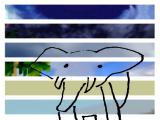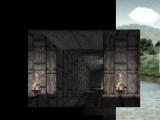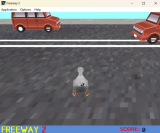I've recently played the game Breakfast on a Wagon With Your Partner, which uses the <<cyclinglink>> macro, and it's inspired a few brief thoughts about the user interface of text choices.
Generally, the interface used for choice, especially dialogue trees, in videogames and Twine games, resembles the following:

Fig. 1: A doctored page from "Breakfast on a Wagon With Your Partner"
A list, usually exhaustive, of the possible choices one could make, usually in an egalitarian fashion. Its exact shape is highly variable, but the important aspect is that every choice is simultaneously visible.
However, the introduction of my <<cyclinglink>> macro has unwittingly introduced an alternative arrangement:

Fig. 2: An actual page from "Breakfast on a Wagon With Your Partner"
A single hyperlink that cycles between choices when clicked, displaying only the current choice. The choice is confirmed by clicking a proper link below.
This differs from the former in a number of interesting ways. Firstly, when you initially approach the page, all of the other options are concealed. Only by clicking the link successively does each option become briefly visible - the choices are presented in a temporal sequence, rather than a spatial sequence. And, not only are the choices themselves hidden, but their quantity as well - a list of 20 choices takes up the same screen space as a list of two.
I feel as if these differences slightly more closely resemble the actual human process of making a decision. Seldom do we, in our minds, see two drastically opposing options appear side-by-side, when confronted with a tough decision. Rather, our minds actively scour themselves for choices, possibilities - the few that appeal to our intuitions rise immediately, and others must be forced up to our conscious realisation, whereupon we focus intently on it. Neither of these link presentations can be said to truly capture this marvelous process, but I like to think that the cyclinglink presentation has more superficial similarities.
One other difference I feel is worth examining is the way in which cyclinglink, in this particular usage, reverses the usual meaning of clicking a hyperlink. Consider the text "I'm not opposed to settling down" in both illustrations. In the first one, the act of clicking it means to commit to the decision - to perform these words. But in the second, the act of clicking it is the act of revising the decision, replacing it with a different possibility. This strikes a somewhat discordant note within me.
Of course, usually a Twine hyperlink doesn't translate to the player verb "act according to these words" - most often it simply means "provoke the computer to delve further into this subject" or "continue a line of thought paused at this point", any of which could somehow revoke or reverse the link text's meaning, relevance or significance. Porpentine has previously called the hyperlink an "omniverb", commenting that its meanings within a game are as varied as the words you could put inside it, and the text that results when you click it. And, indeed, my original impetus for creating this macro was to extend the mechanical potential of links in a playful fashion - links that change unexpectedly when clicked, like a puzzle switch, or a toy, or an animate object in Windosill. Links that are multifaceted, multifarious, capricious. And, indeed, many uses of cyclinglink that I've seen thus far have used it for playful or cute subject matter, where rubbing and touching the story text, and seeing unexpected changes appear, is in keeping with the tone of the story.
I only came to think of cyclinglink as a genuine replacement for the 'choice list', and began considering the implications thereof, when I encountered the above choice in "Breakfast on a Wagon With Your Partner". This story, to its credit, does a very good job of establishing a "hyperlink vocabulary" - a link at the bottom of each page, reading "(o)", serves as the 'confirm choice' button, and is the only one that is used to advance to a subsequent passage. Nevertheless, the cyclinglink still runs contrary to the grain of the traditional hyperlink's meaning - its underline suggests a button waiting to be pushed, rather than a dial waiting to be turned. I hesitated conspicuously when I got to that page, for I had become quite invested in the path of the story, and of my performance as the player-character.
What shall we conclude from this? I believe that the cyclinglink is entirely in keeping with the standard interface of Twine games, and of the versatility that the hyperlink is afforded within a Twine game. I believe further that the use of a cyclinglink for choices, particularly especially mental choices, lends the selection some superficial resemblance to the human act of reaching and developing decisions. However, it is also important that they are sufficiently differentiable from normal links, in situations where it's important the player has full confidence in the presented hyperlinks. This could be through establishing a firm in-game vocabulary, or, more directly, it could be through CSS. (I do not include CSS within the cyclinglink script that forces them to appear differently to normal links, but I do provide CSS hooks that enable them to be styled differently from normal links.)
For a time after adding the variable-alteration functionality to cyclinglink, I wondered if I had perhaps erred by making it produce a Javascript-augmented link - perhaps a more familiar interface element, like a dropdown menu, would be more appropriate for the use cases of this macro. But, I committed to the justification that the hyperlink is the player interface element in Twine games, far more so than even familiar website navigation elements. They are, after all, not web sites, but videogames. So, let the hyperlink's scope be extended so.






Comments
Now do one that
Now do one that automatically cycles every second and you click on it to decide
Zara
Zara I will do this if you pinky-promise that you will use it in a Twine.